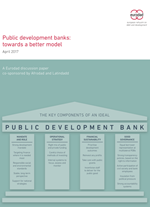Public development banks could be better
Published on Wed, 2017-04-19 17:58
Eurodad published a new report on public development banks, entitled "Public development banks: towards a better model". The report draws on a wide range of existing research and finds there are four main roles that public development banks (PDBs) can play to improve the impact of the financial sector on development. Public development banks (PDBs) are enjoying a resurgence. The global financial and economic crisis has stimulated new interest in PDBs, particularly given the important role they play in providing counter-cyclical financing when private capital is in short supply. In recent years, several countries have established new national and multilateral PDBs, and at the global level they have been recognised for the role they play in the United Nations Financing for Development process. However, not all PDBs succeed, and even the successful ones carry the risk of major negative impacts on development. This may be due to external factors, but significantly, the reasons for their inconsistent performance can also be found in the institutions themselves, which vary considerably, with diverse mandates, roles and operational strategies. PDBs were major players in the financial sector of many economies as they developed, and they continue to play an important role today, particularly in emerging markets. The World Bank estimated in 2012 that statefinanced institutions accounted for “25% of total assets in banking systems around the world”.1 Unlike other kinds of state-owned financial institutions, such as state-owned commercial banks or insurance companies, PDBs have a specific mandate to deliver on public policy objectives that support the economic development of a country or region. Although PDBs are concerned with financial returns, profit is not their overall goal. PDBs are needed because the commercial financial sector is unlikely, of its own accord, to provide the finance needed to support rapid economic development. There are four main ways PDBs can complement the commercial financial sector: • Directing finance to important sectors or regions. Despite the growing amount of work devoted to studying PDBs, a comprehensive approach to analysing these institutions was still missing. This report proposes institutional and governance reforms which challenge PDBs, and the governments which back them, to get better at supporting development, becoming more accountable and learning from past mistakes.The framework for improvement set out in Table 1 should be seen as a complete package – improving one area in isolation is unlikely to deliver development results. Read the full report here. Tags: |


